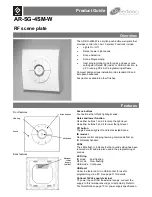
BNDEND
BNDA
BNDB
0x00
Event Memory Depth
Group 1 Memory Depth
Group 2 Memory Depth
T
otal Memory Depth
Basic Operation
855
SPNU563A – March 2018
Copyright © 2018, Texas Instruments Incorporated
Analog To Digital Converter (ADC) Module
An Event Group conversion starts when at least one channel is selected for conversion in this group, and
when the defined event trigger occurs.
If any conversion group is configured to be in a continuous conversion mode, then it needs to only be
triggered once. All the channels selected for conversion in that group will be converted repeatedly.
22.2.1.7 How to Know When the Group Conversion is Completed
Each conversion group has a status flag to indicate when its conversion has ended. See ADEVSR,
ADG1SR, and ADG2SR. This bit is set when a conversion sequence for a group ends. This bit does is
always set if a group is configured for continuous conversions.
22.2.1.8 How Results are Stored in the Results’ Memory
The ADC stores the conversion results in three separate memory regions in the ADC Results’ RAM, one
region for each group. Each memory region is a stack of buffers, with each buffer capable of holding one
conversion result. The number of buffers allocated for each group is programmed by configuring the ADC
module registers ADBNDCR and ADBNDEND.
ADBNDCR contains two 9-bit pointers BNDA and BNDB. BNDA, BNDB, and BNDEND are used to
partition the total memory available into three memory regions as shown in
. Both BNDA and
BNDB are pointers referenced from the start of the results’ memory. BNDA specifies the number of buffers
allocated for the Event Group conversion results in units of two buffers; BNDB specifies the number of
buffers allocated for the Event Group plus Group1 in units of two buffers. Refer to
for
more details on configuring the ADC results’ memory.
ADBNDEND contains a 3-bit field called BNDEND that configures the total memory available. The ADC
module can support up to 1024 buffers. The device supports a maximum of 64 buffers for both the ADC
modules.
Figure 22-3. FIFO Implementation
•
Number of buffers for Event Group = 2 × BNDA
•
Number of buffers for Group1 = 2 × (BNDB – BNDA)
•
Number of buffers for Group2 = Total number of buffers – 2 × BNDB
22.2.1.9 How to Read the Results from the Results’ Memory
The CPU can read the conversion results in one of two ways:
1. By using the conversion results memory as a FIFO queue
2. By accessing the conversion results memory directly
















































